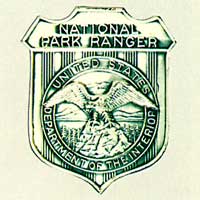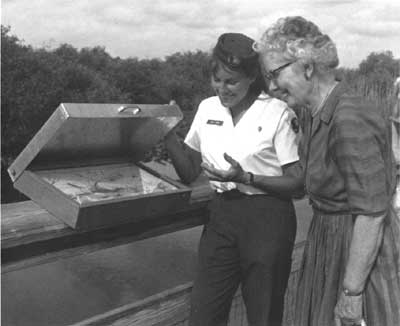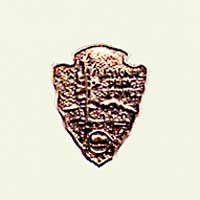![]()
MENU
BADGES
![]() Metal
Metal
Cloth
NPS Associated
ORNAMENTATION
Arrowhead Patch
Belt
Buttons
Cap Insignia
Collar Ornaments
Hat
Hatband & Straps
Law Enforcement Insignia
Length-of-Service Insignia
Nametags
Sleeve Brassards
Tie Ornaments & Pins
Miscellaneous
Conclusion
Photofile
Appendix
Bibliography
Notes

BADGES and UNIFORM ORNAMENTATION
of the NATIONAL PARK SERVICE
BADGES: Metal
In December 1959, new uniform regulations were released, to become effective on January 1, 1961. These regulations called for the number of different badges worn by uniformed personnel to be reduced to three. The small round gold and silver badges of the superintendents and assistant superintendents were discontinued. In their place they both were to wear a "gold rolled fill" badge with NATIONAL PARK RANGER on the top. All park rangers were to wear the same badge, but made of sterling silver and oxidized. This change in material was no doubt to eliminate the unsightly appearance created when the plating wore off the previous badges. All other uniformed personnel (tour leaders, guards, etc.) requiring a badge would wear one like the ranger badge but with NATIONAL PARK SERVICE at the top. These new badges were supplied by V.H. Blackinton & Company of Attleboro Falls, Massachusetts. While at first glance the badges appear to be of the same design as the previous ones, there are a couple of differences. The eagle now faces to the right, and the circle surrounding the eagle contains UNITED STATES DE PARTMENT OF THE INTERIOR instead of NATIONAL PARK SERVICE/DEPARTMENT OF THE INTERIOR. These badges are dapped like the earlier ones.
Although the regulations were not to take effect until 1961, the new badges were probably purchased and issued, if a new badge was required, in 1960. The 1961 regulations are some what ambiguous concerning the use of badges by women. As originally written in 1959. they specifically excluded women from wearing the badge. Under the general heading of "Badge" they state: "The "National Park Service" Badge. All uniformed employees except women [italics added], boat officers and boat crews, lifeguards, nurses, and fire control aids will wear the shield badge." Yet under the heading of "Women's Uniform" they state: "Badge to be worn on coat and optional on shirt." However, this was amended in June 1960 prior to the regulations becoming effective on January 1, 1961, to allow women to wear the "National Park Service" badge. The amendment further states that this badge was to be worn by "tour leaders, guards, and other positions designated by the superintendent". This could be interpreted to mean that women came under "other positions" since there were then no female park rangers. It was suggested at the time that women wear a smaller badge, but this did not happen. [22] Lifeguards and fire control aids had their own badges. | |||
Even though the smaller badge idea was dropped. in January 1962 the wearing of a small silver arrowhead pin was authorized for women "in lieu of a badge". [23] This was unpopular among the women, and justifiably so, for the absence of a badge suggested a lack of authority. Some women were so incensed at this that they refused to wear the arrowhead. In some parks, superintendents issued them standard badges. Mary Bradford relates the experience of when she received her pin, she was very unhappy about it. Visitors did not consider her having any authority and would by-pass her to talk to the "ranger with the badge". So she refused to wear it and requested a badge from her supervisor. He agreed with her and issued her a regular ranger badge. Unfortunately, when she pinned it on her uniform it proved to be too heavy for the material. But, exercising that "old ranger know-how", she stuck the pin through her jacket and fastened it to her bra strap. The arrowhead "badge" issued to Betty Otto when she joined the Service in 1963 resembled the standard ranger tie tack except for having a raised edge, as if it had been made to be enameled in the center, and a pin fastening device. It was also nickel plated rather than sterling, like men's badges. The pins were poorly fashioned and were constantly in need of repair. | |||
 Back
Back
|
Continue

|
Last Modified: Fri, Jan 17 2003 07:08:48 am PDT
http://www.cr.nps.gov/history/online_books/workman1b/volc10.htm
![]()





 Top
Top